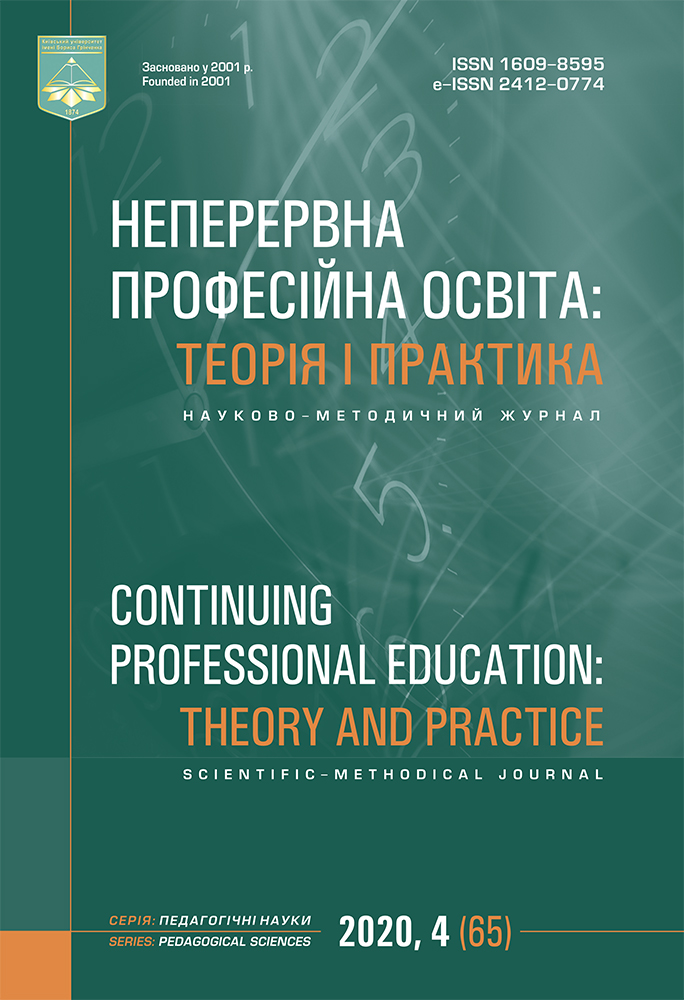ENSURING THE QUALITY OF UNIVERSITY EDUCATION IN CONDITIONS OF BLENDED AND DISTANCE LEARNING
DOI:
https://doi.org/10.28925/1609-8595.2020.4.1Keywords:
blended learning, didactic principles, methods, means and forms of training organization, distance learning, higher education institution, learning process, quality of education, traditional educationAbstract
In modern conditions of reforming the system of higher education, the introduction of time-based blended and distance learning, the mission of higher education is to ensure the efficiency and quality of university education. Therefore, the problem of using blended and distance learning technologies becomes relevant, which, taking into account the peculiarities of the conduct, should ensure the quality of educational services for students. Blended learning is defined as a hybrid of traditional face-to-face and online learning so that instruction occurs both in the classroom and online, and where the online component becomes a natural extension of traditional classroom learning. The article highlights the peculiarities of the introduction of mixed and distance learning at the university, analyzes and clarifies the essence and content of the concepts of « blended learning», «distance learning», identifies the main approaches, methodical principles underlying the organization of the educational process, the priority tasks and advantages of the introduced forms of education are singled out, the tendencies of their development are outlined, in particular in modern conditions. The methods, organizational forms and means used during blended and distance learning are described, specific examples of their introduction at Kyiv International University are given, as well as the schematic structure of the methodical system of the proposed forms of education that ensure the quality of university education. It is proved that blended and distance learning solves the problems of individualization, intensification and optimization of education, is the most effective evolution of the traditional model of learning.References
Bikov, V. Yu. (2001). Proektnij pidhid i distancijne navchannya u profesijnij pidgotovci upravlinskih kadriv. Krimski pedagogichni chitannya: Materiali Mizhnarodnoyi naukovoyi konferenciyi, 30–50.
Zhaldak, M. I. (2003). Pedagogichnij potencial komp’yuterno-oriyentovanih sistem navchannya matematiki [Pedagogical potential of computer-oriented mathematics teaching systems]. Komp’yuterno-oriyentovani sistemi navchannya, 7. 3–16.
Zakon Ukrainy «Pro vyshchu osvitu» [Law of Ukraine On Higher Education] (2014). https://zakon.rada.gov.ua/laws/show/1556-18
Kondakova, M. L., Latypova, E. V. (2013). Smeshannoe obuchenie: vedushie obrazovatelnye tehnologii sovremennosti [Blended learning: leading educational technologies of today]. Vestnik obrazovaniya, 9 (2759), 54–64.
Krivonos, O. M., Korotun, O. V. (2015). Zmishane navchannya yak osnova formuvannya IKT-kompetentnosti vchitelya [Blended learning as a basis for the formation of ICT competence of teachers]. Naukovi zapiski Kirovogradskogo derzhavnogo pedagogichnogo universitetu imeni Volodimira Vinnichenka. Seriya: Problemi metodiki fiziko-matematichnoyi i tehnologichnoyi osviti, 8 (2), 19–23.
Kuharenko, V. M. (2014). Zmishane navchannya [Blended learning]. Vebinar. http://www.wiziq.com/online-class/2190095-intel-blended
Nikitina, M. S. (2012). Teoretiko-metodologicheskie aspekty issledovaniya problemy smeshannogo obucheniya [Theoretical-methodological aspects of the problem of blended learning]. V mire nauchnyh otkrytij, 1. 167–176.
Petuhova, L. Ye., Osipova, N. V. (2010). Elektronna sistema pidtrimki normativno-pravovoyi bazi distancijnoyi sistemi navchannya [Electronic system of support of normative-legal base of distance learning system]. Informacijni tehnologiyi v osviti, 7, 12–18.
Trius, Yu. V., Gerasimenko, I. V. (2012). Kombinovane navchannya yak innovacijna osvitnya tehnologiya u vishij shkoli [Combined learning as an innovative educational technology in higher school]. Teoriya ta metodika elektronnogo navchannya, ІІІ, 299–308.
Baggaley, J. Educational distancing (2020). Distance Education, 41 (4), 582–588. https://doi.org/10.1080/01587919.2020.1821609
Blended Learning. The Clayton Christensen Institute. http://goo.gl/AL3lPN
Collis, B., Moonen, J. (2001). Flexible learning in a digital world: experiences and expectations. Kogan Page Limited.
DreamBox Learning. Blended Learning: 10 Trends (2014, April 25). http://www.dreambox.com/blog/blended-learning-10-trends
Kannan, V., Kuromiya, H., Gouripeddi, S. P., Majumdar, R., Madathil Warriem, J., Ogata, H. (2020). Flip & Pair – a strategy to augment a blended course with active-learning components: effects on engagement and learning. Smart Learning Environments, 7 (1). https://doi.org/10.1186/s40561-020-00138-3
Krismadinata, Verawardina, U., Jalinus, N., Rizal, F., Sukardi, Sudira, P., Ramadhani, D., Lubis, A. L., Friadi, J., Arifin, A. S. R., Novaliendry, D. (2020). Blended learning as instructional model in vocational education: Literature review. Universal Journal of Educational Research, 8 (11 B), 5801–5815. https://doi.org/10.13189/ujer.2020.082214
Lorente, L. M. L., Arrabal, A. A., Pulido-Montes, C. (2020). The right to education and ict during covid-19: An international perspective. Sustainability, 12 (21), 9091, 1–17. https://doi.org/10.3390/su12219091
Ożadowicz, A. (2020). Modified blended learning in engineering higher education during the COVID-19 lockdown-building automation courses case study. Education Sciences, 10 (10), https://doi.org/292, 1–20. 10.3390/educsci10100292
Vo, M. H., Zhu, C., Diep, A. N. (2020). Students’ performance in blended learning: disciplinary difference and instructional design factors. Journal of Computers in Education, 7 (4), https://doi.org/487–510. 10.1007/s40692-020-00164-7
Yılmaz, Ö., Malone, K. L. (2020). Preservice teachers perceptions about the use of blended learning in a science education methods course. Smart Learning Environments, 7 (1), https://doi.org/18. 10.1186/s40561-020-00126-7
Downloads
Published
How to Cite
Issue
Section
License
Copyright (c) 2020 Svitlana Martynenko

This work is licensed under a Creative Commons Attribution-NonCommercial 3.0 Unported License.



